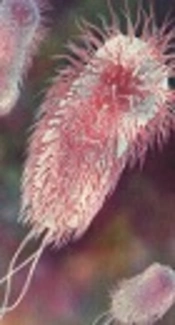1. Introduction
Bloodstream infection is one of the most life-threatening complications and it remains the frequent cause of treatment failure in children with acute lymphoblastic leukemia (1). Nowadays, increasing rates of antibiotic resistance among carbapenem-resistant E. coli isolates is a major concern worldwide (2-5). The production of ß-lactamases, including enzymes of Ambler classes A, D, and B, with the corresponding genes often associated with mobile genetic elements such as plasmids, is the most common mechanism of resistance (6, 7). Extended spectrum beta-lactamases (ESBLs), produced by bacteria, are a rapidly evolving group of β-lactamase enzymes. These enzymes are capable of hydrolyzing aztreonam and cephalosporins (8). CTX-M enzymes are clustered in the class A group of ESBLs and are rapidly scattering among E. coli strains worldwide (9). Up to now, more than 170 allelic variants of this enzyme have been reported (http://www.lahey.org/studies/other.asp#table1). During the past several years, CTX-M enzymes have become the most frequent ESBL enzymes in clinical gram-negative isolates, particularly in South America, Europe, and Asia (4, 10). Herein we describe the isolation of an extended-spectrum β-lactamase (ESBL) producing Escherichia coli from a one-month-old infant with acute lymphocytic leukemia (ALL) in Iran.
2. Case Presentation
A one-month-old female infant with acute lymphoblastic leukemia (ALL) who suffered from blood infection was hospitalized in a hospital of Rasht, Iran, during 2015. Blood culture was carried out in order to detect the causative agent immediately after admission. The blood sample was positive for Escherichia coli. Antimicrobial susceptibility tests were also determined on the isolate by the Kirby-Bauer disk diffusion method using Mast Co (Mast Group, Merseyside, UK) on Mueller Hinton agar (Merck, Germany) and interpreted as recommended by the clinical and laboratory standards institute (CLSI 2014). Escherichia coli ATCC 25922 was used as the control strain. In addition, ESBL production of the isolate was examined using the Combination Disk Diffusion Test (CDDT). In brief, discs containing Ceftazidime (CAZ) and Cefotaxime (CTX) with Ceftazidime 30 µg + Clavulanic (CA) 10 µg and Cefotaxime 30 µg + Clavulanic (CA) 10 µg per disc (Mast Group, Merseyside, UK) were applied on a lawn culture of the isolate. The zones of inhibition were compared for the CTX, CAZ discs and that of the CAZ 30 µg + (CA) 10 µg and CTX 30 µg + CA 10 µg discs. An increase in the zone diameter of ≥ 5 mm around the disks in the presence of clavulanic acid was considered positive for the presence of ESBL in the isolate. K. pneumoniae ATCC700603 and Escherichia coli ATCC 25922 were used as positive and negative controls for ESBL production, respectively. PCR was used to screen the presence of CTX-M-1, CTX-M-2, CTX-M-8, CTX-M-9, and CTX-M-25 genes in this isolate using a PCR purification kit (Bioneer Co., Korea). The presence of ISEcp1, IS26, and IS903 elements was also investigated. Primers and PCR programs used in this study were performed as previously described (11, 12). Sequencing was performed by the Bioneer Company (Korea) and nucleotide sequences were analyzed by FinchTV software and compared with the sequences in GenBank using the NCBI basic local alignment search tool (www.ncbi.nlm.nih.gov/BLAST). The results of antimicrobial susceptibility tests showed that the isolate was resistant to Ampicillin (AMP, 10 µg), Ceftazidime (CAZ, 30 µg), Ceftriaxone (CRO, 30 µg), Amikacin (AK, 30 µg), Ciprofloxacin (CIP, 5 µg), Gentamicin (GEN, 10 µg), Levofloxacin (LEV, 5 µg) and susceptible to Imipenem (IPM, 10 µg). The combination Disk Diffusion Test (CDDT) results revealed that the isolate was positive for producing extended- spectrum β-lactamase (ESBL). The isolate was positive for CTX-M-1 (CTX-M-15), ISEcp1, IS26, and IS903 elements and negative for other CTX-M subclasses.
3. Discussion
The presence of ESBL has been associated with increased mortality, longer duration of hospital stay, and increased hospital cost. Over the past few years, a remarkable increase has been reported in the number of ESBL-E. Coli-associated bloodstream infections in several parts of the world (13, 14). Furthermore, in cancer patients with prolonged hospitalization and with ALL who had received antibiotics for a prolonged period, the opportunity for these bacteria to cause infections enhances (14). Recent data have documented the importance of CTX-M enzymes in the ESBL epidemic around the world (15). ESBL-producing organisms, especially those carrying CTX-M-15, are commonly resistant to cephalosporins as the first-line choice for the treatment of bacteremic patients. Furthermore, ESBL-producing bacteria typically carry genetic determinants that confer resistance to fluoroquinolones and aminoglycosides. Thus, carbapenems, along with other drugs, such as Beta-lactam/beta-lactamase inhibitor combinations, may likely have an increasing role as empirical therapy for patients who are infected with ESBL-producing organisms in community and hospitals (15). In summary, we found an ESBL-producing E. coli in a 1-month-old infant with a blood cancer that carried CTX-M-1 group enzymes. The isolation of such strain from a one-month-old infant with acute lymphoblastic leukemia is a unique event with relevant microbiological, clinical, and epidemiological implications. Infections in cancer and immunocompromised children pose a particular challenge because the pathogens are often unusual. Therefore, appropriate treatment measures must begin early in the course of the infection. On the other hand, resistance genes on mobile elements such as plasmids may easily distribute among individuals and make the situation more difficult to manage. Our finding emphasizes the need for more precise screening methods to identify the causative infectious agent at early stages of infection to choose the appropriate treatment in these severely immunocompromised patients.
